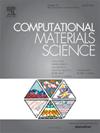BN/PSZ composite polymer: A molecular dynamics study and experimental characterization
IF 3.1
3区 材料科学
Q2 MATERIALS SCIENCE, MULTIDISCIPLINARY
引用次数: 0
Abstract
The excellent insulation, stability, and processability of Polysilazane (PSZ) and its composites have attracted attention. However, due to complex crosslinking and pyrolysis processes and its amorphous nature, numerical simulations on the crosslinking and properties of PSZ and its composites are scarce. This study focuses on a BN/PSZ polymer composite by blending Boron Nitride (BN) with PSZ. Molecular dynamics (MD) investigate crosslinking and thermal conductivity. Results show PSZ forms a network structure during crosslinking, enhancing thermal conductivity pathways with BN, resulting in a significant increase in composite thermal conductivity. With 100 % crosslinking and 79.03 wt% BN, thermal conductivity reaches 4.130 W/(m·K). At the same time, BN/PSZ mixture was prepared by the blending method. After heating and curing the mixture at 250 °C with Nitrogen atmosphere, the obtained cured product was pressed into tablets using a tablet press to observe its thermal conductivity. Comparing the simulation results with the actual test results, the maximum error rate was only 6.05 % at a BN of 60 vol%, which provides highly valuable references for the research on nanofiller/PSZ composites.

求助全文
约1分钟内获得全文
求助全文
来源期刊

Computational Materials Science
工程技术-材料科学:综合
CiteScore
6.50
自引率
6.10%
发文量
665
审稿时长
26 days
期刊介绍:
The goal of Computational Materials Science is to report on results that provide new or unique insights into, or significantly expand our understanding of, the properties of materials or phenomena associated with their design, synthesis, processing, characterization, and utilization. To be relevant to the journal, the results should be applied or applicable to specific material systems that are discussed within the submission.
 求助内容:
求助内容: 应助结果提醒方式:
应助结果提醒方式:


